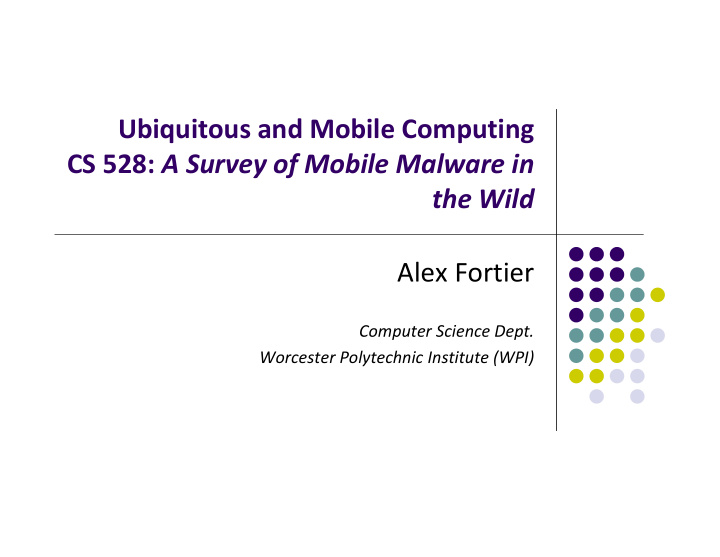



Ubiquitous and Mobile Computing CS 528: A Survey of Mobile Malware in the Wild Alex Fortier Computer Science Dept. Worcester Polytechnic Institute (WPI)
What is mobile malware? Targeted at Android, iOS, Symbian (discontinued), Windows Phone Gather data, send premium ‐ rate SMS messages, credential theft, novelty or amusement Is it more of a problem than traditional malware for PCs?
Root and Motivation Quick comparison: PCs vs. Smartphones
When did this become a problem?
Threat Types Malware Gains access for the purpose of stealing data, damaging the device, annoying user, etc. Personal Spyware Collects personal information over a period of time Grayware Collect data on user, but with no intention to harm user
Security Measures App Markets Apple App Store highly regulated; Apple approves all apps after review Android Market (Google Play Store) similar, but user’s can install applications from elsewhere Permissions Android informs all users of requested permissions at install ‐ time iOS less comprehensive
Incentives Selling user information Stealing credentials For fun!
Findings
Malware Detection Number of Permissions Malicious applications request an average of 6.18 “Dangerous” permissions Non ‐ malicious apps request an average of 3.46 “Dangerous” permissions
Malware Detection Common Permissions 73% of malicious apps requested SMS sending permission 4% of non ‐ malicious apps requested that permission 73% of malicious apps requested READ_PHONE_STATE (IMEI info) 33% of non ‐ malicious apps requested that permission
Malware Detection Application Review iOS: All 4 pieces of Apple malware were spread through jailbroken devices; not found on App Store Symbian: 5 of 24 pieces of malware were Symbian Signed Passed automated review 30% passed or evaded Symbian signing process
Root Exploits Who? Why? Malware authors Gain extra privileges • Perform any action on the phone • Users who want to modify their phone Install homebrew versions of operating • system Can install only applications that are distributed through official application store Cannot perform complete system backups Carriers forbid or restrict tethering (in order to pay additional fee) Carrier pre ‐ install applications (bloatware) and disable their removal Cannot install custom versions of OS that may have additional features
Root Exploits
Future Incentives (as of 2011) Advertising Click Fraud Invasive Advertising In ‐ Application Billing Fraud Governments E ‐ Mail Spam Distributed Denial of Service (DDoS) NFC and Credit Cards
Conclusion
Conclusion Mobile malware rivals desktop malware Human review may be appropriate measure against malware Phone manufacturers should support smartphone customization to minimize root exploits
References Mobile Malware: Protect Yourself Against Evolving Threats ‐ InformationWeek. (n.d.). Retrieved April 28, 2015, from 1. http://www.informationweek.com/mobile/mobile ‐ malware ‐ protect ‐ yourself ‐ against ‐ evolving ‐ threats/d/d ‐ id/1099438? (n.d.). Retrieved April 28, 2015, from http://www.fortinet.com/sites/default/files/whitepapers/10 ‐ Years ‐ of ‐ Mobile ‐ 2. Malware ‐ Whitepaper.pdf A. P. Felt, K. Greenwood, and D. Wagner. The Effectiveness of Application Permissions. In USENIX WebApps, 2011. 3. Mobile malware grows by 614 percent in last year ‐ CNET. (n.d.). Retrieved April 28, 2015, from 4. http://www.cnet.com/news/mobile ‐ malware ‐ grows ‐ by ‐ 614 ‐ percent ‐ in ‐ last ‐ year/ M. Boodaei. Mobile Users Three Times More Vulnerable to Phishing Attacks. Trusteer Technical Report. 5. W. Enck, M. Ongtang, and P. McDaniel. On Lightweight Mobile Phone Application Certification. In CCS, 2009. 6. P. Porras and H. Saidi and V. Yegneswaran. An Analysis of the Ikee.B (Duh) iPhone Botnet. SRI International, 2009. 7. http://mtc.sri.com/iPhone. A. Schmidt, H. Schmidt, L. Batyuk, J. H. Clausen, S. A. Camtepe, and S. Albayrak. Smartphone Malware Evolution Regisited: 8. Android Next Target? In MALWARE, 2009.
Recommend
More recommend